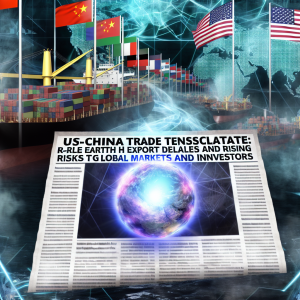China’s Economic Crossroads: What Investors Must Know Beyond the Headlines
China’s economic landscape is at a pivotal juncture, and savvy investors need more than surface-level data to navigate the complexities ahead. Recent reports highlight mixed signals: producer prices suggest cost savings, yet domestic consumption remains sluggish. Retail sales in May improved to a 6.4% year-over-year increase, up from 5.1% in April, signaling some momentum. But beneath this headline, consumer sentiment remains fragile, posing a significant challenge to Beijing’s ambitions to boost internal demand.
Why does this matter? Because weak consumer confidence exposes China’s economy to external shocks—namely, ongoing US tariffs and tepid global demand. This dynamic pressures Chinese policymakers to roll out fresh stimulus measures. However, as Alicia Garcia Herrero, a respected economist, points out, the current fiscal stimulus is heavily infrastructure-focused. While infrastructure projects can jumpstart growth, they do little to shift China’s economic model toward the much-needed consumption-led growth. Herrero underscores that for a real rebalancing, the People’s Bank of China (PBoC) must take the lead by further lowering interest rates. Yet, this move carries risks: a weaker yuan (RMB) amid sensitive US-China trade negotiations could provoke market volatility and diplomatic friction.
Adding to the optimism, People’s Bank of China advisor Huang Yiping recently forecasted Q2 GDP growth exceeding 5%, with room for expanded fiscal policy. The National People’s Congress Standing Committee’s June 24 meeting is a key event to watch, as any new directives will shed light on Beijing’s strategic direction—particularly whether it will prioritize consumption or continue leaning on infrastructure and exports.
Investment Implications: What Should You Do?
-
Monitor Policy Signals Closely: The next few weeks are critical. Investors should track announcements from the National People’s Congress and PBoC closely. A shift toward more aggressive monetary easing could spark short-term market rallies but also increase currency risks.
-
Focus on Sectors Poised to Benefit from Stimulus: Infrastructure-related sectors may see continued support if fiscal stimulus remains infrastructure-heavy. Conversely, consumer discretionary stocks might lag unless policy pivots to boost household spending.
- Watch Currency Movements: A weakening RMB could impact multinational companies with China exposure and affect the broader Asia-Pacific market. Hedging currency risk might be prudent for portfolios with significant China holdings.
Hong Kong and Mainland China Stocks: Riding the Waves of Uncertainty
Despite trade uncertainties, both Hong Kong and Mainland China equity markets have posted monthly gains in June, extending the recovery from May. The easing of US-China trade tensions and the Iran-Israel ceasefire have buoyed risk appetite, but major indices remain below their March peaks, reflecting cautious investor sentiment.
- Mainland China’s CSI 300 and Shanghai Composite Index rose 1.55% and 2.03%, respectively, in June.
- The Hang Seng Index gained a robust 3.70%.
- Year-to-date, the Hang Seng Index is up an impressive 20.40%, driven largely by tech stocks.
- The Hang Seng TECH Index’s 18.76% YTD gain notably outperforms the Nasdaq Composite’s modest 1.66% rise, despite ongoing US tech export restrictions.
This divergence highlights an important trend: Mainland and Hong Kong tech stocks are proving resilient, even under geopolitical pressure. For investors, this signals an opportunity but also a cautionary tale about reliance on US technology and the potential for policy-driven disruptions.
What’s Next for Investors?
- Tech Sector Vigilance: The tech sector’s outperformance is enticing, but investors must stay alert to regulatory shifts and export controls that could impact future earnings.
- Trade Deal Developments: Progress toward a US-China trade deal remains a key catalyst. Positive developments could unlock further gains, while stalled negotiations may cap upside.
- Domestic Demand Shift: Long-term growth hinges on China successfully transitioning to a consumption-driven economy. Watch for policy signals that indicate a genuine push in this direction.
Unique Insight: The Consumer Sentiment Paradox
A recent survey by the China Household Finance Survey (CHFS) reveals a paradox: while urban consumers report rising incomes, their willingness to spend remains constrained by uncertainty over job security and global trade tensions. This “wait-and-see” attitude could blunt the effectiveness of stimulus measures focused solely on infrastructure. For investors, this means that betting solely on a rebound in consumer spending may be premature without clear policy shifts.
In conclusion, China’s economy is navigating a complex web of internal and external challenges. Investors who dig deeper—beyond headline GDP figures and stock index movements—will be better positioned to capitalize on emerging opportunities and mitigate risks. Stay tuned to policy developments, monitor sentiment trends, and balance exposure across sectors to thrive in this evolving landscape.
Source: US-China Trade: Rare Earth Approvals Stall and Tariff Woes Mount

